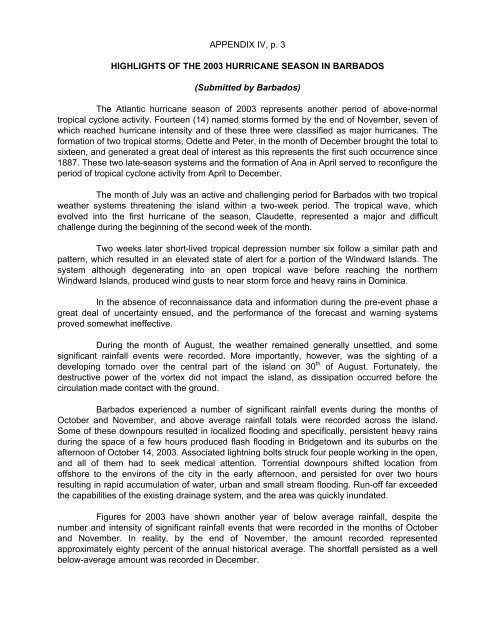RA IV Hurricane Committe, Twenty-sixth session - WMO
RA IV Hurricane Committe, Twenty-sixth session - WMO
RA IV Hurricane Committe, Twenty-sixth session - WMO
Create successful ePaper yourself
Turn your PDF publications into a flip-book with our unique Google optimized e-Paper software.
APPENDIX <strong>IV</strong>, p. 3<br />
HIGHLIGHTS OF THE 2003 HURRICANE SEASON IN BARBADOS<br />
(Submitted by Barbados)<br />
The Atlantic hurricane season of 2003 represents another period of above-normal<br />
tropical cyclone activity. Fourteen (14) named storms formed by the end of November, seven of<br />
which reached hurricane intensity and of these three were classified as major hurricanes. The<br />
formation of two tropical storms, Odette and Peter, in the month of December brought the total to<br />
sixteen, and generated a great deal of interest as this represents the first such occurrence since<br />
1887. These two late-season systems and the formation of Ana in April served to reconfigure the<br />
period of tropical cyclone activity from April to December.<br />
The month of July was an active and challenging period for Barbados with two tropical<br />
weather systems threatening the island within a two-week period. The tropical wave, which<br />
evolved into the first hurricane of the season, Claudette, represented a major and difficult<br />
challenge during the beginning of the second week of the month.<br />
Two weeks later short-lived tropical depression number six follow a similar path and<br />
pattern, which resulted in an elevated state of alert for a portion of the Windward Islands. The<br />
system although degenerating into an open tropical wave before reaching the northern<br />
Windward Islands, produced wind gusts to near storm force and heavy rains in Dominica.<br />
In the absence of reconnaissance data and information during the pre-event phase a<br />
great deal of uncertainty ensued, and the performance of the forecast and warning systems<br />
proved somewhat ineffective.<br />
During the month of August, the weather remained generally unsettled, and some<br />
significant rainfall events were recorded. More importantly, however, was the sighting of a<br />
developing tornado over the central part of the island on 30 th of August. Fortunately, the<br />
destructive power of the vortex did not impact the island, as dissipation occurred before the<br />
circulation made contact with the ground.<br />
Barbados experienced a number of significant rainfall events during the months of<br />
October and November, and above average rainfall totals were recorded across the island.<br />
Some of these downpours resulted in localized flooding and specifically, persistent heavy rains<br />
during the space of a few hours produced flash flooding in Bridgetown and its suburbs on the<br />
afternoon of October 14, 2003. Associated lightning bolts struck four people working in the open,<br />
and all of them had to seek medical attention. Torrential downpours shifted location from<br />
offshore to the environs of the city in the early afternoon, and persisted for over two hours<br />
resulting in rapid accumulation of water, urban and small stream flooding. Run-off far exceeded<br />
the capabilities of the existing drainage system, and the area was quickly inundated.<br />
Figures for 2003 have shown another year of below average rainfall, despite the<br />
number and intensity of significant rainfall events that were recorded in the months of October<br />
and November. In reality, by the end of November, the amount recorded represented<br />
approximately eighty percent of the annual historical average. The shortfall persisted as a well<br />
below-average amount was recorded in December.

















